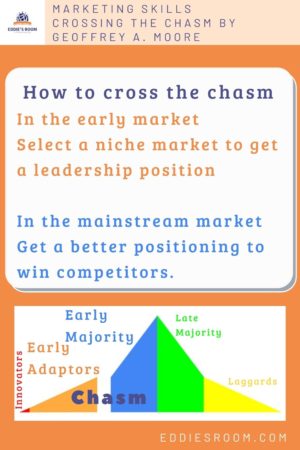This is a famous book on high-tech marketing. We can learn the marketing strategy and necessary action about how to cross the chasm.
Crossing the Chasm
It is to make the transition from early market to the mainstream market.
In the early market, there are Innovators known as Technology Enthusiasts and Early Adopters known as Visionaries.
And in the mainstream market, there are Early Majority known as Pragmatist and Late Majority known as Conservatives and Laggards known as Skeptics.
The chasm is between Visionaries and Pragmatists. We need to understand the Visionaries and Pragmatists.
Early adaptors
- The Visionaries
- Leading industry
- Look for a breakthrough with building new infrastructure
- Accept the risk of new technology
Early Majority
- The pragmatists
- Following industry trend
- Look for improvements on existing infrastructure
- Avoid the risk of new technology

How to cross the chasm
1st step of crossing the chasm is to select a niche market and get a leadership position.
Trying to cross the chasm without taking a niche market approach is like trying to light a fire without kindling
How to select target market to be the leader.
No one knows about the target market and no reliable data is available because it’s a niche market. So we have to accept this low data situation to make important decisions about target market selection. The author advised
Now, the biggest mistake one can make in this state is to turn to numeric information as a source of refuge or reassurance.
The detailed process of the target market selection is written in the book. So please check the author page to read “Crossing the Chasm by Geoffery A. Moore“.
Positioning in the mainstream market
If the market size is small, customers can accept the sole supplier. So we don’t care about competition and positioning.
But if the market size is getting bigger customers have to have multiple suppliers to have a stable product supply and competitive price. Then customers select some suppliers.
Generally, the pragmatists want to compare suppliers so we may need to create competitors. And positioning is an important marketing factor.
And it means we have to shift from Product-Centric value to Market-Centric value.
Product-Centric vs. Market-Centric
1. Fastest product vs. Largest installed base
2. Easiest to use vs. Most third party supporters
3. Elegant architecture vs. De facto standard
4. Product price vs Cost of ownership5. Unique functionality vs. Quality of support
In addition to the author’s view as shown above, I would like to share my view from my experience.
Product-Centric vs. Market-Centric
1. Fastest product vs. Fast enough product
2. Easiest to use vs. Easy to use
3. Elegant architecture vs. Effective architecture
4. Product price vs. Better cost performance
5. Unique functionality vs. Standard functionality
The author picks up 4 points and I like the first one as follows.
Positioning, first and foremost, is a noun, not a verb. That is, it is best understood as an attribute associated with a company or a product, and not as the marketing contortions that people go through to set up that association.
Please check the rest of the 3 items if you are interested in positioning.
Positioning statements
I’m sure it is a good exercise to think about a positioning statement for your product or service. It’s just filling in the underlined part.
For (target customers – beachhead segment only)
Who are dissatisfied with (the current market alternative)
Our product is a (new product category)
That provides (key problem-solving capability).
Unlike (product alternative),
We have assembled (key whole product features for your specific application).
Here is an example of a positioning statement of Eddie’s room.
For a lifelong learner and/or father like me
Who are dissatisfied with any learning resources
Our product is an Eddie’s Room
Unlike other websites
We have assembled some kinds of topics to share the learning experience and motivate you to learn together.
Thank you for reading his post.
Please check the author’s website.


